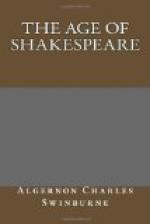just twenty-three years before. The only figure
equally prominent in either play is that of Thersites:
but Heywood, happily and wisely, has made no manner
of attempt to rival or to reproduce the frightful
figure of the intelligent Yahoo in which the sane
and benignant genius of Shakespeare has for once anticipated
and eclipsed the mad and malignant genius of Swift.
It should be needless to add that his Ulysses has
as little of Shakespeare’s as of Homer’s:
and that the brutalization or degradation of the god-like
figures of Ajax and Achilles is only less offensive
in the lesser than in the greater poet’s work.
In the friendly duel between Hector and Ajax the very
text of Shakespeare is followed with exceptional and
almost servile fidelity: but the subsequent exchange
of gifts is, of course, introduced in imitation of
earlier and classic models. The contest of Ajax
and Ulysses is neatly and spiritedly cast into dramatic
form: Ovid, of course, remains unequalled, as
he who runs may read in Dryden’s grand translation,
but Heywood has done better—to my mind at
least—than Shirley was to do in the next
generation; though it is to be noted that Shirley
has retained more of the magnificent original than
did his immediate precursor: but the death of
Ajax is too pitiful a burlesque to pass muster even
as a blasphemous travestie of the sacred text of Sophocles.
In the fifth play of this pentalogy Heywood has to
cope with no such matchless models or precursors;
and it is perhaps the brightest and most interesting
of the five. Sinon is a spirited and rather amusing
understudy of Thersites: his seduction of Cressida
is a grotesquely diverting variation on the earlier
legend relating to the final fall of the typical traitress;
and though time and space are wanting for the development
or indeed the presentation of any more tragic or heroic
character, the rapid action of the last two acts is
workmanlike in its simple fashion: the complicated
or rather accumulated chronicle of crime and retribution
may claim at least the credit due to straightforward
lucidity of composition and sprightly humility of style.
In “Love’s Mistress; or, The Queen’s
Masque,” the stage chronicler or historian of
the Four Ages appears as something more of a dramatic
poet: his work has more of form and maturity,
with no whit less of spontaneity and spirit, simplicity
and vivacity. The framework or setting of these
five acts, in which Midas and Apuleius play the leading
parts, is sustained with lively and homely humor from
induction to epilogue: the story of Psyche is
thrown into dramatic form with happier skill and more
graceful simplicity by Heywood than afterward by Moliere
and Corneille; though there is here nothing comparable
with the famous and exquisite love scene in which
the genius of Corneille renewed its youth and replumed
its wing with feathers borrowed from the heedless and
hapless Theophile’s. The fortunes of Psyche
in English poetry have been as curious and various




